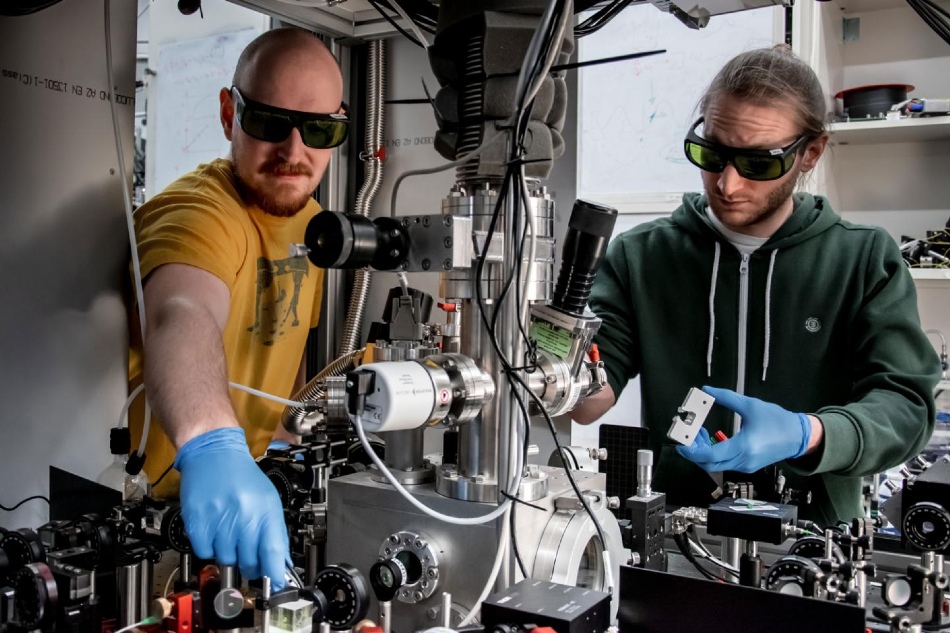Jan 31 2020
A well-known fact is that it is feasible to control and manipulate the quantum properties of individual atoms using laser light.
 Scientists from Vienna, Kahan Dare (left) and Manuel Reisenbauer (right) working on the experiment that cooled a levitated nanoparticle to its motional quantum ground state. Image Credit: © Lorenzo Magrini, Yuriy Coroli/University of Vienna.
Scientists from Vienna, Kahan Dare (left) and Manuel Reisenbauer (right) working on the experiment that cooled a levitated nanoparticle to its motional quantum ground state. Image Credit: © Lorenzo Magrini, Yuriy Coroli/University of Vienna.
It would be possible to push even huge clouds of hundreds of millions of atoms into the quantum regime, which leads to the emergence of macroscopic quantum states of matter such as Bose-Einstein condensates or quantum gases. At present, these states are also extensively used in quantum technologies. A fascinating next step would be to extend such a level of quantum control to solid-state objects.
When compared to atomic clouds, a solid’s density is a billion times higher, and all atoms are restrained to collectively move along the center of mass of the object. Thus, new macroscopic quantum states that include huge masses should be feasible.
But it is not so easy to enter this new regime. The first stage in realizing such a level of quantum control is to separate the to-be-investigated object from the effects of the environment and to eliminate all thermal energy. Thermal energy removal is achieved by cooling it to temperatures very close to absolute zero (−273.15 °C) so that the motion of the particle is dominated by quantum mechanics.
The researchers demonstrated this by opting to experiment with a glass bead with a size nearly thousand times smaller compared to a typical grain of sand and including a few hundred million atoms. The particle was isolated from the environment by optically capturing it in a securely focused laser beam under high vacuum.
This trick that was originally proposed by Arthur Ashkin, a Nobel laureate, several decades ago, and is also employed for isolating atoms.
The real challenge is for us to cool the particle motion into its quantum ground state. Laser cooling via atomic transitions is well established and a natural choice for atoms, but it does not work for solids.
Uros Delic, Study Lead Author, University of Vienna
Therefore, the researchers have been striving to implement a laser-cooling technique that was suggested by Austrian physicist Helmut Ritsch at the University of Innsbruck and, autonomously, by Vladan Vuletic, study co-author, and Nobel laureate Steven Chu.
Recently, they had reported a first-ever demonstration of the working concept, “cavity cooling by coherent scattering.” But they were still restricted to working very far from the quantum regime.
“We have upgraded our experiment and are now able not only to remove more background gas but also to send in more photons for cooling,” says Delic. In this fashion, it would be possible to cool the glass bead’s motion straight into the quantum regime.
It is funny to think about this: the surface of our glass bead is extremely hot, around 300 °C, because the laser heats up the electrons in the material. But the motion of the center of mass of the particle is ultra-cold, around 0.00001 °C away from absolute zero, and we can show that the hot particle moves in a quantum way.
Uros Delic, Study Lead Author, University of Vienna
The team is thrilled about the possibilities of their study. Apart from the Vienna researchers, various other teams across the globe have investigated the quantum motion of solids. To date, experimental systems were formed of nano- and micromechanical resonators, typically diving boards or drums clamped to a rigid support structure.
Optical levitation brings in much more freedom: by changing the optical trap—or even switching it off—we can manipulate the nanoparticle motion in completely new ways.
Nikolai Kiesel, Study Co-Author and Assistant Professor, University of Vienna
Various concepts have been put forward in this regard, apart from others by Oriol Romero-Isart and Peter Zoller, Austrian-based physicists at Innsbruck. The concepts may now become feasible.
For instance, together with the most recently realized motional ground state, the researchers believe this opens new prospects for unrivaled sensing performance, the analysis of basic processes of heat engines in the quantum regime, and the investigation of quantum phenomena that involve huge masses.
“A decade ago we started this experiment motivated by the prospect of a new category of quantum experiments. We finally have opened the door to this regime.”